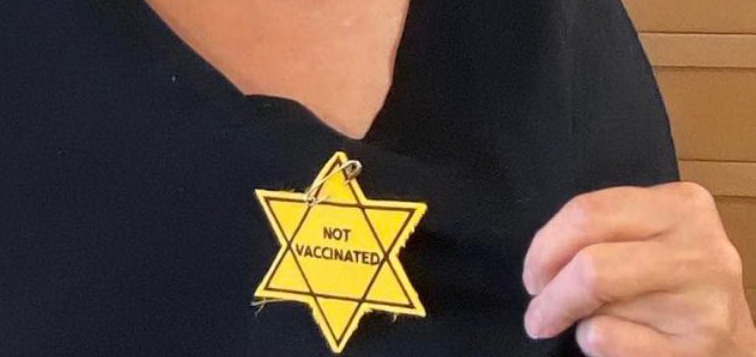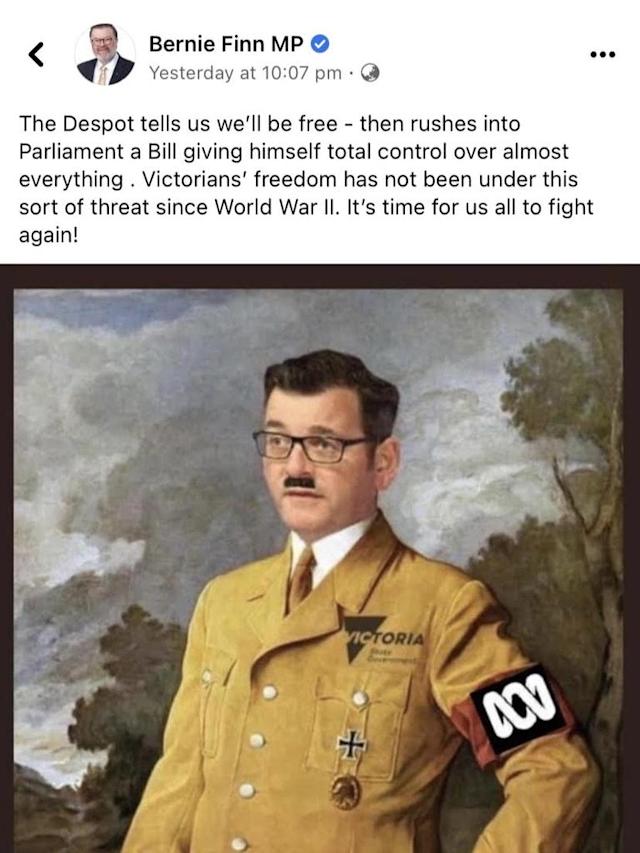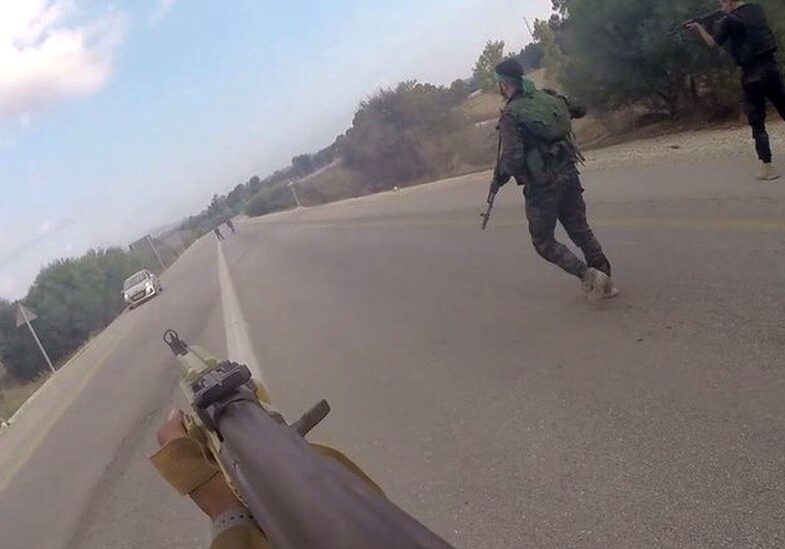Australia/Israel Review
A Pandemic of Holocaust Distortion
Nov 24, 2021 | Naomi Levin

COVID policies and Nazi claims
Holocaust denial is well understood as a form of antisemitism. Holocaust deniers, writes Deborah Lipstadt in her seminal book Antisemitism: Here and Now, “are, pure and simple, antisemites, and their agenda is to reinforce and spread the very antisemitism that produced the Holocaust.”
But today we are seeing the rise of a different, but equally concerning, phenomenon: Holocaust distortion. Unfortunately, Holocaust distortion is becoming increasingly visible in Australia, particularly among those who oppose mandatory COVID-19 vaccinations and lockdown measures.
As a member of the International Holocaust Remembrance Alliance (IHRA), there is an argument that the Australian Government could be doing more to combat growing Holocaust distortion in Australia and being spread by Australians online.
In Melbourne, demonstrators opposed to vaccination mandates and new pandemic-related laws have displayed signs depicting Victorian Premier Daniel Andrews as Adolf Hitler and calling Andrews’ Labor Party the “Nazi party” with increasing frequency.
In November, when Queensland Premier Annastacia Palaszczuk announced restrictions for Queenslanders who had not received a COVID-19 vaccination, her Government was also branded as “Nazis” by social media users.
In Sydney, an anti-vaxxer took to TikTok to rage against a Toyota dealer in Brookvale because it was “enforcing Nazi regulations” which prevented him entering.

Portraying political leaders such as Victorian Premier Dan Andrews as Nazis is itself reaching epidemic proportions
Victorian Liberal MP Bernie Finn, who has been a vocal – and often controversial – critic of Andrews, was rightly slammed for posting an image of Andrews as Hitler. Finn removed the image after being roundly condemned, including by members of his own party.
In mid-October, Country Liberal Party Senator Sam McMahon compared vaccine mandates in the Northern Territory to Nazi Germany, saying “you could be forgiven for thinking we’re living in Nazi Germany, not the Northern Territory.”
This followed a July Facebook post from Queensland Senator Malcolm Roberts of Pauline Hanson’s One Nation Party, who wrote to his 110,000 Facebook followers: “There are eerie parallels between NAZI Germany and what is happening in our country today. While Germans are wonderful people, it did not take long for the German govt to stop basic freedoms and then have Germans murdering their fellow Germans.”
One of Senator Roberts’ followers heartily replied, “Yes, they are planning a genocide…”. Another wrote a slightly garbled message, but the meaning was clear: “absolute truth and thank god that someone is reminded of the history of the Nazis that is really happening again before our eyes only in other gloves.”
Yellow Stars of David, which Jews were infamously forced to wear by the Nazis, have also been appropriated by this ragtag group. Most prominently, media reported on NSW Central Coast-based Sarah Mills, a popular social media influencer, who published photos of herself and her three children wearing yellow stars and instead of “Jude” (German for Jew), she had printed “no vax” on them.
To borrow a cliché, these examples are the absolute tip of the iceberg when it comes to comparisons between COVID-19 regulations and the Holocaust. They also represent a global phenomenon.
In early November, Italians wore striped pyjamas similar to those worn by prisoners in Nazi concentration camps to protest against the introduction of a “green pass” that allows vaccinated Italians access to work and public venues. In Lithuania, Germany and the Czech Republic, protesters have worn similar garb. In the United States, legislators compared COVID-19 vaccines to the work of barbaric Nazi medical experimenter Josef Mengele.
The trend toward Holocaust distortion is not new, but it is evolving. Its contemporary origins seem to lie among Israel haters. To return to Lipstadt’s book, she writes about “genocide inversion”, where Israelis – and sometimes all Jews – are equated with Nazis, especially in times of struggle with the Palestinians. These accusations against Israelis, she writes, “hearken back to medieval antisemitism accusations – murdering non-Jews to achieve world domination.”
Lipstadt continues, “Some observers posit that these comparisons are used precisely because by upsetting people – Jews in particular – they draw immediate attention. In other words, they constitute a kind of ‘Jew baiting’.”
But the trend has expanded beyond Israel comparisons, and has become so widespread that earlier this year, the IHRA and the UN Educational, Scientific and Cultural Organisation (UNESCO), jointly published a guide called “Recognising and Countering Holocaust Distortion”. The guide is intended to provide expert advice to policymakers and community leaders to help fight Holocaust distortion.
Since 2013, the IHRA has had a definition of Holocaust distortion. This definition has now been updated to specify that “The use of imagery and language associated with the Holocaust for political, ideological, or commercial purposes unrelated to this history” is one form of Holocaust distortion.
Apart from the obvious distress that Holocaust distortion causes to all right-minded people and the fact that it diminishes the memory of the Holocaust, there are other dangers.
In an IHRA video presentation published in November, Hungarian Holocaust expert Andrea Szonyi, director of the Zachor Foundation for Social Remembrance, explained: “Holocaust distortion is a threat to society because we will totally lose historical accuracy, we will not be able to build on the facts, we cannot learn from them and we can fall into the trap of forgetting and repeating.”
Holocaust distortion is being used by pandemic protesters because they are ignorant of the facts of the Holocaust and because, as the ultimate evil, comparisons to the Holocaust are seen as a useful way of pushing their agenda. The main vehicle for pushing Holocaust distortion is, unsurprisingly, social media, particularly online forums where conspiracy theorists lurk. It is one more dangerous and distressing trait of these dangerous, distressing and seemingly growing communities of conspiracists.
Speaking at the US Anti-Defamation League’s recent conference “Never is Now”, Imran Ahmed, CEO of the Centre for Countering Digital Hate, explained that there has been a recent proliferation of conspiracy theories.
“We see these [conspiracies] recur over time, but the speed with which they can build audiences, and what always underpins these theories, is it was the Jews that were behind it and that’s why we’ve got to get them,” Ahmed explained.
Conspiracy theories are being effectively spread via social media, which has a business model of amplifying controversial, emotional or contentious messaging while diminishing the exposure of analytical, balanced and reasoned reporting.
“Social media permits the production of fake evidence points, things that simulate news sites, for example, but are in fact misinformation,” Ahmed said. “The algorithms that underpin a major way that 4.5 billion people worldwide now communicate, social media, actually elevate misinformation, hate, contentious information above good information because, frankly, hate, controversy, chewy stuff that people start debating whether they are for or against, is more interesting than agreement and tolerance.”
In “Recognising and Countering Holocaust Distortion”, the IHRA advocated for a variety of approaches to be used to respond to Holocaust distortion. Recommended approaches included disseminating fact-based counter-narratives and education campaigns to highlight the unique nature of the Holocaust. The report also urges IHRA members – of which Australia is one – to identify and track Holocaust distortion and develop ways to counter its spread online.
The report describes Holocaust distortion as “in many ways a more pernicious threat” than Holocaust denial and a development made more acute by the “rise of post-truth politics and proliferation of online hate.” It is important that Australia acts – both as part of its responsibilities as a member of the IHRA and because of the importance to our own society of preserving and handing down an accurate memory of the Holocaust.
RELATED ARTICLES

Protests were always about the delegitimisation and demonisation of Israel: Joel Burnie on Sky News

AIJAC congratulates MPs Josh Burns and Julian Leeser on the McKinnon Prize




